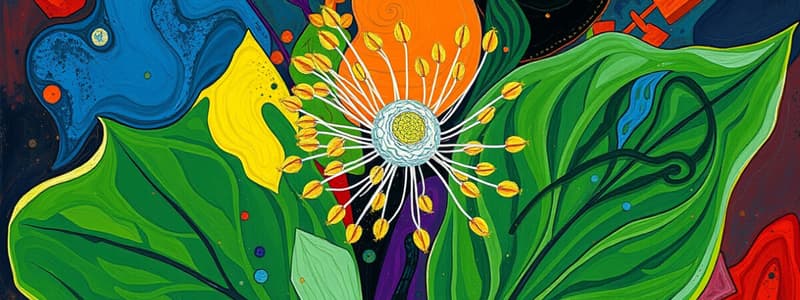Podcast
Questions and Answers
Dormancy allows plants to survive adverse conditions by minimizing growth rates.
Dormancy allows plants to survive adverse conditions by minimizing growth rates.
True (A)
Auxins can be used to produce fruits without fertilization.
Auxins can be used to produce fruits without fertilization.
True (A)
Water-dispersed seeds rely on their heaviness to ensure they sink quickly to the ground.
Water-dispersed seeds rely on their heaviness to ensure they sink quickly to the ground.
False (B)
Self-dispersal involves seeds being ejected from dried pods due to external factors.
Self-dispersal involves seeds being ejected from dried pods due to external factors.
Tomato seeds can germinate without passing through the digestive system of animals.
Tomato seeds can germinate without passing through the digestive system of animals.
The radicle is the first part of the new plant to emerge from the seed, developing into the shoot.
The radicle is the first part of the new plant to emerge from the seed, developing into the shoot.
In monocots like maize, food for the developing embryo is stored in the cotyledons.
In monocots like maize, food for the developing embryo is stored in the cotyledons.
Testa serves as a tough seed coat to protect the seed during dormancy.
Testa serves as a tough seed coat to protect the seed during dormancy.
Seedless fruits are produced solely through natural pollination.
Seedless fruits are produced solely through natural pollination.
The function of fruit is solely to provide nutrients to the seed.
The function of fruit is solely to provide nutrients to the seed.
In dicots, food storage occurs in the endosperm rather than in the cotyledons.
In dicots, food storage occurs in the endosperm rather than in the cotyledons.
Dormancy in seeds occurs when they dry out after being fully formed.
Dormancy in seeds occurs when they dry out after being fully formed.
Cotyledons in seeds are responsible for storing food reserves during early germination.
Cotyledons in seeds are responsible for storing food reserves during early germination.
Seed dispersal does not play a critical role in the survival of plant species.
Seed dispersal does not play a critical role in the survival of plant species.
The integuments of the ovule develop into the seed coat.
The integuments of the ovule develop into the seed coat.
Study Notes
Plant Hormones and Fruiting
- Auxins are plant hormones used to induce fruiting without fertilization.
Seed Dispersal
- Dispersal ensures survival by relocating seeds away from the parent plant, reducing competition.
Animal Dispersal
- Seeds are ingested by animals, passing through their intestines where digestive enzymes can aid germination.
- Examples include tomato and apple seeds, which require this process for germination.
Wind Dispersal
- Seeds must be lightweight and possess a large surface area to facilitate wind transport.
- Notable examples include sycamore and dandelion seeds.
Self-Dispersion
- Pea pods dry and develop lines of weakness, curling and splitting to eject seeds.
- Gorse exemplifies self-dispersing plants.
Water Dispersal
- Seeds contain air pockets to keep them buoyant, allowing for long-distance dispersal.
- The yellow water lily showcases this dispersal method.
Dormancy
- Dormancy is a period of reduced growth/metabolism despite suitable germination conditions.
Advantages of Dormancy
- Protects plants from adverse conditions that could harm new growth.
- Allows seeds to spread, reducing competition.
- Gives embryos time to mature until conditions improve.
Breaking Dormancy
- Seeds often have waterproof coatings (Testa) that prevent water entry, maintaining dormancy until conditions are favorable.
Seed Formation
- Post-fertilization, the ovule swells and toughens to form the seed coat.
- The zygote develops into a seed embryo, while the triploid endosperm becomes a food storage system.
- The integuments thicken to form the protective Testa.
Seed Structure
- Embryo: Develops into the new plant.
- Testa: Tough outer coat protecting the seed.
- Radicle: First root part to emerge.
- Plumule: Develops into the shoot.
- Cotyledons: Seed leaves that store food, can be one (monocots) or two (dicots).
Seed Types
- Endospermic seeds (e.g., maize, wheat) store food in the endosperm.
- Non-endospermic seeds (e.g., broad bean) store nutrients primarily in cotyledons.
Fruit Formation
- Fruits protect seeds and aid in dispersal.
- Seedless fruits, like watermelons, are developed through genetic selection or treatment to break seed dormancy.
- Chemical soaking can wash out inhibitors, and application of hormones can enhance fruit production.
Germination
- Germination is the process when a seed begins to grow.
Requirements for Germination
- Water: Acts as a solvent and medium for hormones/enzymes.
- Oxygen: Essential for aerobic respiration and energy production.
- Temperature: Necessary for enzyme activity.
- Food: Reserves in the seed provide energy for new tissue development.
Stages of Germination
- Emergence of the radicle forms the root.
- Plumule grows upwards to form the shoot, leading to initial weight loss.
- Leaves break the surface, initiating photosynthesis, and the plant starts gaining weight.
- Hypogeal Germination: Seed remains underground.
- Epigeal Germination: Seed grows above ground.
Asexual Reproduction
- Involves no gametes, resulting in genetically identical offspring to the parent plant.
Studying That Suits You
Use AI to generate personalized quizzes and flashcards to suit your learning preferences.
Related Documents
Description
Explore the role of plant hormones, particularly auxins, in inducing fruiting without fertilization. This quiz also delves into the mechanisms of seed dispersal, including animal dispersal and its significance for plant survival and reproduction.





